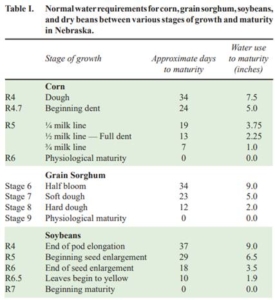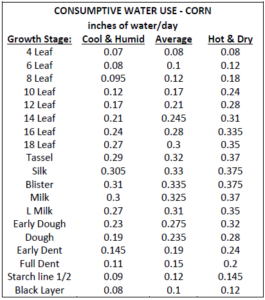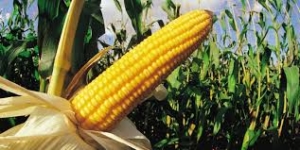Agronomic Update – August 13, 2020….Steady as she goes…..
 A little farm physics humor….I’m not sure many of us needed to be home schooling to come up with something like this when we were kids….
A little farm physics humor….I’m not sure many of us needed to be home schooling to come up with something like this when we were kids….
Topics:
- Growing Degree Day Update
- What’s going on in my fields?….Corn Development, Disease, Crop Water Use, Maturity Timeline….
- Soybean Development Update….
- Pioneer Seeds – Yield Estimator App…
As of August 12th, we have accumulated approximately the following for Growing Degree Days in 2020:
Planting Date GDD’s2020 Average GDD Departure from average
April 21 2082 1943 +139 (+6 days)
April 26 2029 1904 +125 (+5.5 days)
May 1 1978 1864 +114 (+5 days)
As far as GDU’s are concerned, we continue to trend above normal for the year. Since the last update two weeks ago, we continue to be 5-6 days ahead of the normal and 8-10 days ahead of 2019. We have averaged 21 GDu’s/day over the past two weeks and the forecast is predicting basically the same per day over the next 14 days as well.


These two maps are the forecast maps for temperatures over the next 6-10 and 8-14 days. It looks like we will continue to have overall temps be conducive to grain-fill as we seem to be in the normal to slightly above normal area for temps over the next two weeks. Cooler temps slow down crop development, but respiration slows more than photosynthesis, which is why it is a positive to yield and overall late-season plant health to have have as much sunlight as we can get. Cooler days usually means an extended grain-fill period.


These two maps are the forecast maps for precipitation over the next 6-10 and 8-14 days. It appears that, while we may have temps conducive to grain-fill, we will be on the drier side during this time frame. This will keep irrigation needs to the forefront and possibly impact dryland yields, especially soybeans.
What’s going on in my field?
Much of the corn crop is in the Dough to Beg. Dent stage, with some of the later planted corn in the Late-Milk stage.
- When the plant reaches Dough, kernel abortion will no longer take place, and any yield reduction from then on out will be from lower test weights.
- We are seeing more inconsistency in ear size within some fields, mainly due to the uneven emergence we
- As mentioned above, cooler temps during grain fill means less stress on the crop, which is a positive for high yields.
- As far as sunlight is concerned, we are running 3% below the average since silking started. Overall sunlight has been better the past two weeks of fill versus the first two weeks of fill. Sunlight, of course, is now a much bigger yield factor, since we are now in the crucial grain fill period. As such, how much sunlight and when it occurs during the grain-fill period, will play a role in overall yield and late-season plant health. From our preliminary observations, we are not seeing any major ear tip-back, which can occur from reduced sunlight early in the grain-fill period.
- Relative Humidity is tracking 7% higher than normal since grain-fill started. Overall, we are not seeing a significant increase in leaf diseases on corn. Much of the area has been treated with fungicides, but even on those fields that have not been treated, we are seeing low to moderate infestations of Gray Leaf Spot, with minimal Northern Corn Leaf Blight….Southern Rust is present but has not increased over the past 7 or so days. If anything, we continue to see a lot of bacterial leaf streak in the area.
- Overall insect pressures are currently light in area fields. We still see Western Bean Cutworm infestations in untreated fields…heaviest pressures on the later planted fields. Corn earworms are also present in low numbers. Seeing a few Spider Mite colonies, but overall numbers very low.
- Crop water use has been averaging .20/day for the Elgin area for corn, with soybeans slightly above that. With the cooler temps, we have been seeing lower overall ET rates for both crops. Keep the following figures in mind as the crop moves forward….corn in the R4/Dough stage will still require 7.5-8.2″ of water and Soybeans in R5/Beginning Seed still require over 6.5-7.5″ of water….again, we are currently sitting at these stages of growth.
- The tables below are the UNL ET rates and they show daily averages and total crop water needs for corn and soybeans during the grain-fill periods.


Corn Maturity Timeline


- Considering our current stage of growth, we are looking at approximately 30-35 days to maturity.
- This matches up pretty well with what we are seeing in the field. The two week forecast is predicted to see a GDU accumulation of 335 GDU’s. Add this to the above totals and by August 26th, we should have accumulated approximately 2419 GDU’s using an April 21st planting date…just 80 shy of
- If this trend occurs as forecasted, we are looking at corn maturity to occur around September 10-20th depending upon hybrid maturity. Once corn reaches 1/2 milk line it is considered Full Dent. We have the potential for an extended grain-fill period, which will be conducive to higher yields and hopefully improved late-season plant health.
Soybean Update
- The soybean crop is currently in the R5 (beginning seed) stage of growth. The later planted soybeans fields are late-R4.
- As mentioned above, total water needs at this stage are over 6.5″
- We are starting to see areas of White Mold show up in some fields. Areas of infestation are still minor, but expect these areas to grow in size over the next few weeks.
- We are beginning to see some fields with scattered plants showing early Sudden Death Syndrome(SDS) symptoms over the past week. Expect to see these symptoms and areas increase in size over the next few weeks as well. Remember, the most effective SDS management opions (ILeVO seed treatment coupled with varietal tolerance) are done when the planter leaves the field. We continue to see an overall increase in this disease from year-to-year. https://www.pioneer.com/us/agronomy/sudden_death_syndrome_cropfocus.html
- Insect pressure continues to be light in area fields. Hardly any Soybean Aphids present. Bean Leaf Beetle numbers are also low.
Pioneer Seeds – Yield Estimator App

The Pioneer Seeds app is a great tool that allows you to take pictures of corn ears and estimate yield using your smart phone! This app uses ear photometry technology that Pioneer researchers have used for several years and it is available to customers for FREE. You can adjust the yield estimate based on harvestable ear count and kernels per bushel (kernel weight). I would use 85,000 kernels/bu for yellow corn as a conservative starting point right now, but you can get a range of estimates by trying several different kernel/bushel settings. As always, the more ears used in the sample the more accurate the estimates will be. I recommend using the tool later in the grain-fill period, especially once the grain gets to ½ milk line stage or later; anything before that and the yield estimates vary greatly. Go to wherever you download apps for your device and search PIONEER SEEDS to get the free Pioneer Seeds app.
Thanks for your support and business!! Please contact us with any questions, observations, or concerns you may have!
Starman Seed Service, Inc.

